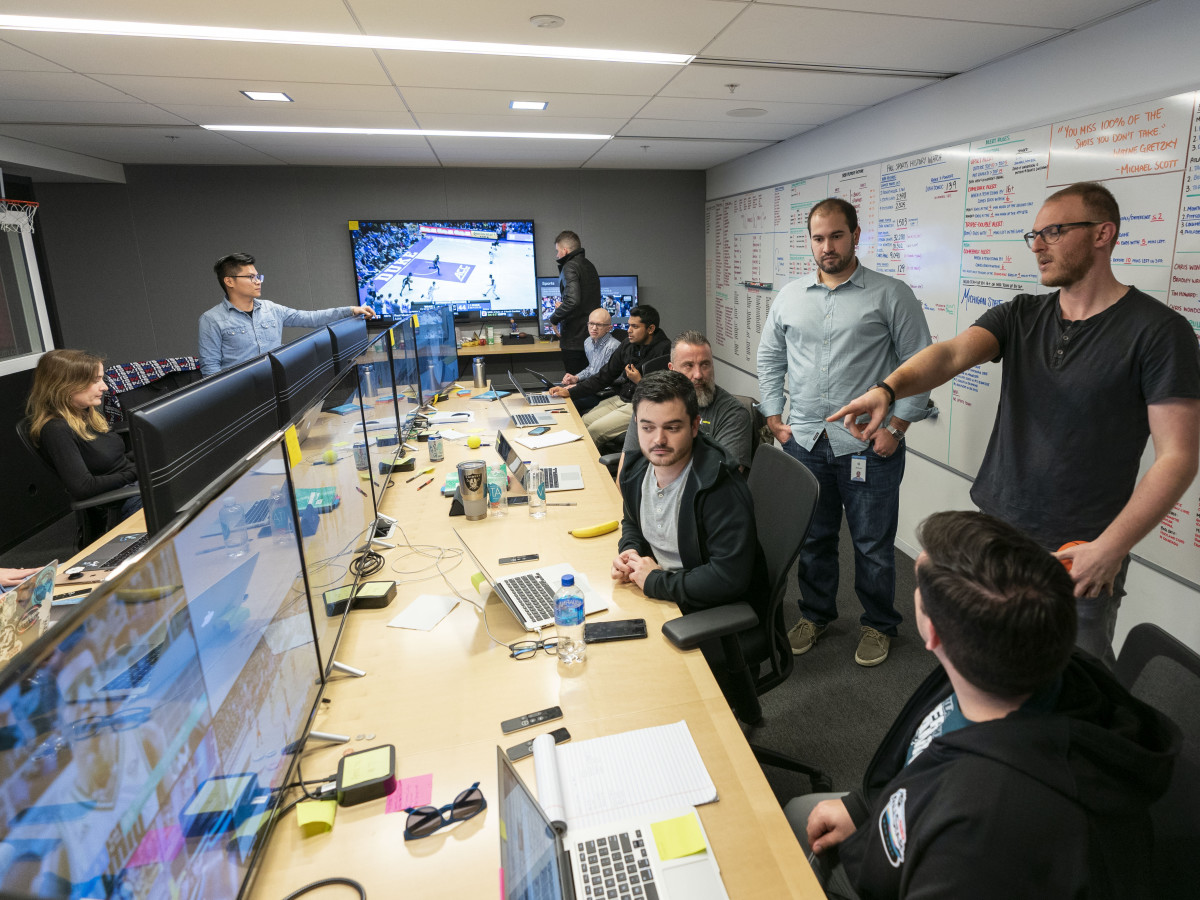Inside Apple's Sports Surveillance Room That Could Change the Way We Watch Live Events

CUPERTINO, CALIF.— On the second floor of a Silicon Valley office complex, in a conference room crowded with a dozen workers and three times as many devices, Apple is watching sports for you.
They’ve been at it for almost a year now, keeping an eye on minor tennis tournaments, spring training baseball, college lacrosse, even curling. The team manages the sports subsection in Apple’s TV app and its Apple TV interface, highlighting what’s available around the clock. But a well-programmed computer could pretty much deliver that. The workers—including several sports industry vets and at least one former college athlete—look for newsworthy and unpredictable moments, sending notifications when the action gets exciting or deciding something is skippable. Alert users of a triple-overtime NBA game between two lottery teams? Nope. A fourth overtime? O.K., send it.
It’s been 18 years since Apple disrupted music by extracting the song from the album. Now, it’s joined other companies separating moments from their games. The goal is to offer the curated convenience of highlights without sacrificing the thrill of live. Don’t miss another moment, the pitch goes, but don’t wait for one either.
A whiteboard stretches the length of the room, stuffed with definitions for college basketball upsets (unranked team over top-15 opponent, or top-5 team losing to anyone outside the top 10) and NBA comebacks (any team down 16 or more that cuts the lead to less than seven) worth alerts. Other regions of the wall are covered with standings and historical marks to be referenced at a moment’s notice. Office inside jokes, friendly wagers, and blindingly hot takes make the board too. So does a Wayne Gretzky quote via Michael Scott. You know the one. The curator’s hall of fame lives in the far corner, anchored by the group’s mini hot dog maker.

Technically, this meeting place is called Theremin. In this building on Apple’s Results Way campus dominated by Apple Music, every conference room is named after an instrument. But inside, near the only window and next to the women’s college basketball rankings, the spot has been rechristened. The name recognizes this industry’s geeky foundation while also setting this specific group apart. Welcome To The Sports Ball Room.
Next week, Apple is expected announce its foray into the streaming business and its upcoming premium video service. The company has reportedly budgeted $1 billion for original content, including a deal with Kevin Durant’s production company for a basketball drama. But don’t expect the tech giant to venture into live broadcasts. Asked how much he’s thinking about competing against Facebook and Amazon (both of which have begun airing games) with exclusive rights, Apple senior vice president for Internet software and services Eddy Cue says, “Not a lot, honestly.”
“That’s not to say we would never do sports, because who the heck knows,” he said. “Never is a long time, but I don’t think that’s a problem right now.” Sports rights are deeply fragmented, with different owners split by platform and region. “You really can’t own all the rights, so therefore at some point you need to solve some other problems,” Cue said. “You can’t design for owning the rights because if that’s the only thing you’re doing you’re always going to be tiny.” And these days, Apple rarely does tiny.
Traditionally, the company hasn’t done much sports, either. While the iPhone launched with first-party News, Weather, and Stocks tools, Apple never built Sports. Steve Jobs was an avid swimmer but never got into spectating. Current CEO Tim Cook, however, is on the board of the National Football Foundation and Nike. And Cue, one of Cook’s top lieutenants, has become one of the Warriors’ most high-profile fans. In pictures, his office could be confused for a coach’s, with a signed Duke football helmet and an encased pair of sneakers serving as bookends on his shelf.
Leaning back in a conference room chair a floor below the Sports Ball Room, wearing running shoes, jeans and a faded blue henley, Cue describes a sports curation product that sounds like it was designed for himself as much as for Apple’s users. Searching for an example of its usefulness, he doesn’t turn to any buzzworthy game from the last year. Instead he reaches back for Kobe’s 81-point showing in an otherwise unremarkable Lakers-Raptors game amidst the 2006 NFL playoffs. “It was amazing to watch, but the vast majority even of Lakers fans didn’t see it,” he said. “As a fan, I’ve always looked at it as an opportunity.”
In a world of infinite supply, Cue wants to be the middleman, letting fans know what’s worth watching and offering one-click access to action rather than worsening the fragmentation. For Apple, there are financial benefits there. The company takes a cut of sports subscription services purchased on iOS and, on a high-level, can leverage its exclusive software into hardware profits.
Limitations currently prevent the app from serving as a complete package. Certain video providers are missing from Apple’s aggregated offering. Several sports aren’t tracked as closely as the big ones. Customization options are lacking. And you’re still going to have to go elsewhere for sports news and highlights. As they like to say in this part of the world, we’re still in the first inning here.
The guide of the future, Cue believes, will know about your fantasy teams and maybe even the bets you’ve made, making suggestions based on that information. Recommendation engines currently power tech behemoths YouTube, Netflix and Instagram. It’s only a matter of time before a good one sweeps the sports viewing landscape, whether or not it originates in Theremin.
Then there will be a backlash. There is something beautiful about settling into a game’s rhythm, they’ll say. A buzzer-beater won’t be enjoyable anymore if you see them every night. Of course, no one will stop you from watching the old-fashioned way. Minimalist fans will emerge, purging themselves of distractions while dedicating time to a single sport, team, or game. But they’ll stay in the minority.
We swipe to date and tap to eat. We shop at the office and work at the mall. The internet has knocked down barriers. Waiting is now a tragedy. So why spend an evening sitting in front of a game, hoping for magic? There are simply too many compelling alternatives.
If the sports viewing experience is disrupted, the NCAA tournament could change fastest. There are already multiple games to hop between, and plenty of fans wait for a text or tweet before tuning in, hoping to catch a moment of transcendence. Eventually, that approach could become a year-round norm. The thrill of following a single team for a season might be replaced by a season of chasing thrills. Constant madness. Introducing: RedZone for everything.
On Super Bowl Sunday, the sports curation team gathered in their office, prepared for the big game. Then, nothing happened. At least that would be the rational conclusion based on the lack of notifications sent. While Apple pushed three alerts for the preceding AFC Championship game—messaging fans when there were four minutes left, entering overtime, and ahead of the game-winning kick—the employees could only sit around and jokingly discuss letting people know about Big Boi’s halftime appearance as the Patriots squashed the Rams. Which raises the question: Was the Super Bowl worth watching? Or, at least, did you enjoy seeing it? Was it time well spent?
Historically, the question wouldn’t make sense. It was the Super Bowl, after all. To this day, sports continues to demand appointment viewing when little else does. If you’re a sports fan, you watched. But what if you didn’t have to?
